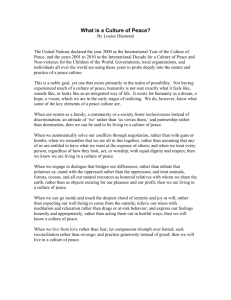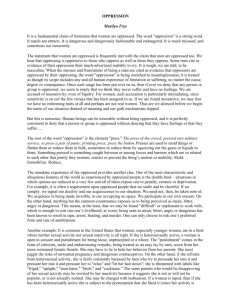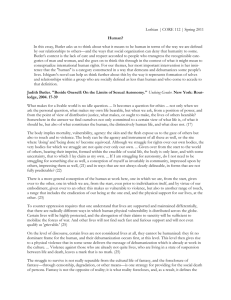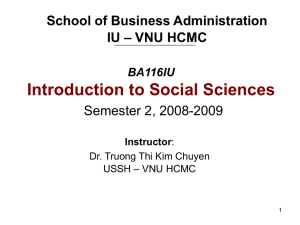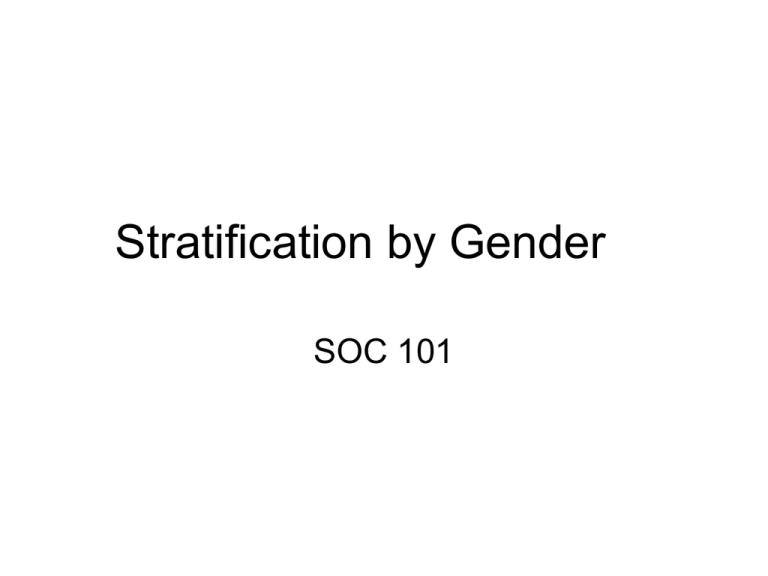
Stratification by Gender
SOC 101
Basic Concepts
• Sex is biological—we are either male or female
(chromosomes, anatomy, hormones)
• Gender is a social construct—masculinity or
femininity (social and cultural expectations that
we learn.)
• Gender Roles—role a person is expected to
perform because they are male or female.
The Social Construction
of Gender
• Gender Roles
– Expectations regarding proper behavior,
attitudes, and activities of males and
females
Sex/Gender Roles
Social Construction of Gender
• Gender roles are socially constructed so that
male-female differences are either created or
exaggerated
• Most people do not display strictly “masculine” or
“feminine” qualities all the time
The Social Construction
of Gender
Feminine Role
1.
2.
3.
4.
5.
6.
Nurturing
Expressive
Soft
Emotional
Sweet
Submissive
Masculine Role
1.
2.
3.
4.
5.
6.
7.
No “girly-stuff”
Success
Self-reliant
Aggressive
Active
Sexual
Dominant
• Parents play a critical role at guiding
children into gender roles
• The media helps perpetuate exaggerated
gender roles.
• Men face lots of pressure to conform to
traditional male roles in society.
• Traditional gender roles have restricted
females more than males.
The Social Construction
of Gender
Men’s Gender Roles
• Attitudes toward parenting changing, but
studies show little change in tradition male
gender role
• Boys who successfully adapt to cultural
standards of masculinity may grow up to be
inexpressive men who cannot share their
feelings with others
Androgyny – is a lifestyle in which there is
no gender role differentiation and one can
be both “masculine” and “feminine”
Explaining Stratification by
Gender
• The Functionalist View
– Gender differentiation contributes to social
stability.
– Women take on expressive, emotionally
supportive roles.
– Men take on instrumental, practical roles.
Explaining Stratification by
Gender
• The Conflict Response
– The relationship between men and women is
one of unequal power.
– Men have a dominant position over women.
– Gender differences are a result of the
subjugation of women by men.
Explaining Inequality
by Gender
• The Interactionist Approach
– Study micro level of everyday behavior
• Men more likely than women to:
–
–
–
–
Change topics of conversation
Ignore topics chosen by women
Minimize ideas of women
Interrupt women
Explaining Inequality
by Gender
Table 12-2. Sociological Perspectives on Gender
Sexism and Sex Discrimination
Sexism – the ideology that one sex is
superior to the other.
• U.S. society run by male-dominated
institutions
Women the Oppressed Majority
Women continue to be underrepresented in every
section of society.
• Politics
• Certain segments of education
• Corporate America
Women in the Workforce
• In 2000, 60 percent of adult women held jobs
outside the home
• Vast majority of women enter sex-typed
occupations.
• Women are underrepresented in occupations
historically defined as “men’s jobs” which often
pay more.
Women: The Oppressed
Majority
█ Figure 12.1: Percentage of Adult Women in the Paid Labor Force by
Country
Source: Bureau of Labor Statistics 2001a.
Women: The Oppressed
Majority
█ Table 12.2: U.S. Women in Selected Occupations, 2001: Women as
Percentage of All Workers in the Occupation
Underrepresented
Firefighters
Airline pilots
Engineers
Police
Clergy
Dentists
Computer systems analysts
Lawyers
Physicians
Mail carriers
College teachers
Overrepresented
3%
4
10
14
15
20
27
29
29
31
43
High school teachers
Social workers
Cashiers
File clerks
Elementary teachers
Librarians
Registered nurses
Child care workers
Receptionists
Secretaries
Dental hygienists
59%
72
77
82
83
86
93
97
97
98
98
Source: Bureau of the Census 2002a:381-383.
Glass Ceiling
Glass Ceiling – is an invisible barrier that blocks the
promotion of a qualified individual in a work environment
because of the person’s gender, race or ethnicity.
• These workplace patterns have one crucial result:
women earn less money than men.
• Women are more likely to be poor than men.
Women: The Oppressed
Majority
• Sexual Harassment
– Occurs when work benefits are contingent
on sexual favors or when touching, lewd
comments, or appearance of pornographic
material creates a “hostile environment” in
the workplace
Must be understood in the context of continuing
prejudice and discrimination against women
Women: The Oppressed
Majority
• The Social Consequences of
Women’s Employment
– Second Shift: Sociologist Arlie Hochschild
describes the double burden of housework and
childcare following work outside the home as the
“second shift”
Women spend 15 fewer hours each week in
leisure activities than their husbands
Women: Emergence of a Collective
Consciousness
The feminist movement of the United States
originate in 1848.
• Women were granted the right to vote in 1920.
• The movement re-emerged in the 1960s to
battle sexist attitudes and the position of women
in the workforce.
Women: The Oppressed
Majority
• The Status of Women Worldwide
– Women’s and men’s worlds differ in access
to education and work opportunities
• Women in the Workforce of the U.S.
– Women’s participation in paid labor force in
U.S. increased steadily throughout the 20th
century
• Census bureau found 2 occupations out of 821 in which
women typically earn about 1% more income than men
Women: The Oppressed
Majority
Figure 12-1. Gender
Inequality in
Industrial Nations
Source: Fuwa 2004:757
Women: The Oppressed
Majority
Figure 12-2. Trends in U.S. Women’s Participation in the Paid Labor
Force, 1890—2003
Sources: Bureau of the Census 1975; 2004a:396
The Social Construction
of Gender
• Cross-Cultural Perspective
– Gender stratification requires:
• Individual socialization into traditional gender
roles within family
• Promotion and support of traditional roles by
other social institutions
– Every society has men and women who
resist and successfully oppose stereotypes



